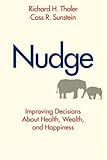
In Nudge, the authors' introduction immediately resonated with me as a dietitian. In it they discuss a hypothetical school cafeteria that incorporates wisdom from supermarket designers by `selling' products simply by placing them in different positions.
When I worked with clients, I told them what they should be eating, and what they shouldn't. My podiatrist tells me not to wear stilettos and my physio tells me that I should do my joint rehab exercises as well as, or instead of fun exercise.
Imagine if we could just gently nudge people in the direction of healthier choices, rather then simply telling them what to do. This is the concept behind the book Nudge.
I would recommend Nudge to anyone who is trying to promote better health to individuals, communities or within organizations.
Richard Thaler is a Professor at The University of Chicago, Booth School of Business. His co-author, Cass Sunstein is a Law Professor at the University of Chicago. Their research over the past 30 years has been in behavioural economics, looking at how people make decisions, and the science of choice.
Within Nudge the authors describe Libertarian Paternalism as a weak, soft, and non-intrusive type of paternalism because choices are not blocked fenced off, or significantly burdened. However, because they describe and encourage techniques for Governments, organisations and individuals to consciously attempt to nudge people towards making healthier choices, it still counts as paternalistic.
Those trying to nudge people into making better choices are Choice Architects, where they design and manipulate the environment to make it easier or more fun to make the most beneficial choice. Although this may be described as manipulative, it's important to note that there is no neutral design, whenever you design an environment; it will influence choices of your clients or customers. If you are responsible for designing a stairwell, you can make it easy to access, aesthetically pleasing, with natural light will encourage people to take the stairs over the elevator or escalator. If you are designing a menu, making healthy choices the default option will make it easier for customers to choose that option. If you design the stairwell or the menu that makes it easier for the least healthy option to be chosen, it will be. If you do nothing, you are not doing nothing, you are being a choice architect without considering the consequences.
Relevance to Health Professionals
All health professionals can all gain something out of ideas presented in Nudge. We understand the science and the why of health and medicine, but the barriers in getting clients to do, what we want them to do, for their own health, can be a challenge. Nudge uses numerous health examples, such as how a school cafeteria can help students choose healthier food; how we can increase organ donation; and strategies to increase compliance in taking prescription medicine.
Before you become a choice architect, it is important to understand the outcomes you are trying to achieve and determine whether any of the options suggested by Thaler and Sunstein:
* Making the healthiest option the easiest choice
* Making the healthiest option enjoyable
* Making the healthiest option the default choice
* Making unhealthy choices more difficult
* Giving incentives for choosing healthiest choices
* Giving positive feedback for choosing healthiest choicesGet more detail about Nudge: Improving Decisions About Health, Wealth, and Happiness.
No comments:
Post a Comment